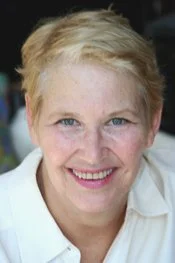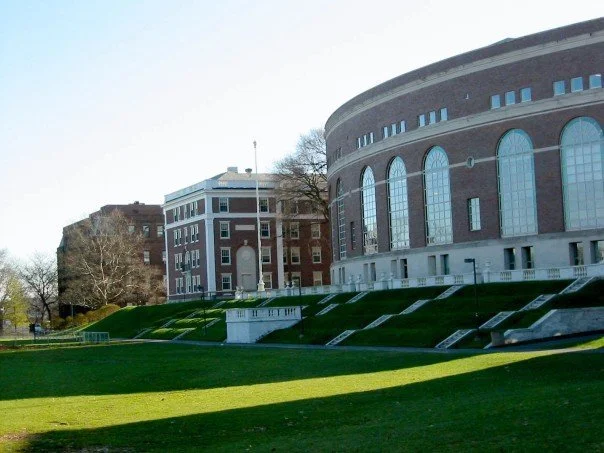
Why we need schedules
Annie Dillard.
— Photo by Phyllis Rose
At Wesleyan University, in Middletown, Conn. The view from Foss Hill: From left to right: Judd Hall, Harriman Hall (which houses the Public Affairs Center), and Olin Memorial Library
“How we spend our days is, of course, how we spend our lives. What we do with this hour, and that one, is what we are doing. A schedule defends from chaos and whim. It is a net for catching days. It is a scaffolding on which a worker can stand and labor with both hands at sections of time. A schedule is a mock-up of reason and order—willed, faked, and so brought into being; it is a peace and a haven set into the wreck of time; it is a lifeboat on which you find yourself, decades later, still living.”
―Annie Dillard (born 1945), in The Writing Life. The American author of fiction and nonfiction books taught for 21 years at Wesleyan and has long had a summer house on Outer Cape Cod, a place that she has frequently written about.
‘Had their look down’
Wesleyan University’s Samuel Wadsworth Russell House, built in 1828, home to the school’s Philosophy Department. The building was designated a National Historic Landmark in 2001 and is considered one of the finest examples of Greek Revival architecture in the country.
“I remember I grew up in Pasadena in a very, kind of, homogeneous, kind of, suburban existence and then I went to college at Wesleyan University in Connecticut. And there were all these, kind of, hipster New York kids who were so-called 'cultured' and had so much, you know, like knew all the references and, like, already had their look down.’’
Mike White (born 1970), screenwriter and actor
Don Pesci: Avoid 'cheap grace': Bring migrant kids to Conn.
U.S. Border Patrol officers processing migrant children in Texas
Central American migrants charging their phones in Mexico City on their way to the U.S. border.
VERNON, Conn.
The crisis at the border has now officially become “a border crisis.” A story in The Hartford Courant boldly labels it as such: “Lamont was personally asked by Vice President Kamala Harris recently if Connecticut could provide space for some of the thousands of children who are being kept in detention centers along the Texas border after fleeing from their Central American countries. Their numbers have increased as the federal government is facing a border crisis (emphasis mine).”
“Crisis” is not a term often found waltzing around with the new administration of President Joe Biden. But it has become impossible in recent days for Friends Of Biden (FOBs) to overlook the massive numbers of illegal – shall we, for once, call things by their right names? -- immigrants that have poured over the US border after Biden, a few weeks into his presidency, opened the door to illegal immigration while telling the huddled masses yearning to breathe free in Honduras, Guatemala and Mexico, “Don’t come in just yet. We’re not ready for you.”
They came, in numbers impossible to ignore.
Biden honeymooners scattered throughout the United States have managed thus far to obscure the predictable consequences of Democratic attempts to rid the nation of any trace of Trumpism. Slathering such failed attempts with political slant-ointment has not worked to obliterate the failed results of Biden’s thoughtless border policies. George Orwell taught us that the most difficult thing that writers must do is to notice what is lying right under their noses, and some people in the news business have taken his admonition to heart.
The unmanageable influx of illegal immigrants quickly became a crisis after the Biden administration disassembled Trump’s effective, though imperfect, multiple solutions to illegal border crossings. The Trump protocols included a wall, much derided by anti-Trump Democrats; an arrangement with south-of-the-border states that illegal immigrants passing through other countries on their way to the United States must apply for asylum in the pass-through countries, and tighter border security. All this was washed away, mostly by executive fiats, following Biden’s elevation to the presidency.
The came the deluge. Suddenly everyone was woke.
Now that the immigration horses have escaped the barn, the Biden administration is reconsidering patching breaches in the border wall and bribing – shall we call things by their right names for once? -- South American countries plagued for decades by failed socialist policies, so that the governments of said countries might consider giving the Biden administration a hands-up concerning illegal border crossings.
Answering a plea from Vice President Kamala Harris, Connecticut Gov. Ned Lamont has agreed to lend a hand as well. After all, why should a border crisis that affects the entire nation be borne solely by California, Arizona, New Mexico and Texas, states lying on our country’s mystical borders?
Good question. Is it not a form of cheap grace for progressives in Connecticut to refuse to put their muscle where their mouths have been? This time, Connecticut progressives are not marching in lockstep with their brother progressives in the Biden-Harris administration.
Connecticut progressives are wiggling on the point. Middletown Mayor Ben Florsheim, perhaps the most progressive politician in the history of Middletown {home of Wesleyan University}, expressed reservations. “Taking kids out of cages in the Southwest and moving them into cages in the Northeast, Florsheim said, “is not an immigration policy. This is a literal decommissioned child prison. It’s a detention facility.” Actually, was a detention facility; no one has been detained in the closed Connecticut Juvenile Training School since April 12, 2018. Then too, Harris was not whispering policy prescriptions into Lamont’s ear during her visit to Connecticut. She was begging Lamont to let down a much needed political life line and, really, doesn’t the temporary housing in Connecticut of distressed children merit a soupcon of compassion from the progressive Mayor of Middletown? We are, after all, a nation of immigrants.
The Connecticut Justice Alliance’s executive director Christina Quaranta, said that the former juvenile-detention center “was not built to care for, support, or heal youth — especially youth already going through such significant trauma. Even if all evidence that [the training school] is a maximum security, hardware secure facility is removed, it still remains a large, cinderblock building, with inadequate living space for young people.”
Nope, Lamont said, “I visited there last week. I had no idea what to expect: cafeterias, classrooms, big outdoor recreation, indoor rec areas. I think the federal government would come in and make sure that when it came to where people actually sleep, they can do that in a way that the kids feel safe and feel like they’re at home. It’s secure, but it’s also welcoming.”
And that is the point, isn’t it? Lamont and Harris are right on this one: Connecticut should share the burden of national problems – the sooner the better. Welcoming illegal immigrant children to a facility that easily can be adjusted to meet their needs is no different than welcoming illegal immigrants into Connecticut’s sanctuary cities, and progressives who lodge flimsy objections to this mission of mercy are practitioners of cheap grace.
The crisis elsewhere should come home to roost, if only to show that Connecticut is better than those who pray in the church of cheap grace. Jesus, incidentally, called the practitioners of cheap grace “the tombs of the prophets.”
Don Pesci is a columnist based in Vernon.
Michael Tyre: Colleges must make physical campuses foster students' affinity
On the campus of Wellesley College, in Wellesley, Mass. It’s considered one of the loveliest campuses in America, which may help explain the high rate of alumnae donations to the women’s college.
Quinnipiac University’s Lender School of Business, with dome, with Sleeping Giant in background, in Hamden, Conn.
From The New England Journal of Higher Education, a service of The New England Board of Higher Education (nebhe.org)
The brand of a college or university is more than its logo or tagline. It’s an accumulation of experiences for students, staff, faculty, alumni and community members. Marketing is part of it, but every time someone sets foot on your campus, they are walking into your brand.
This fall, fewer students will be on campuses and they may be there with less frequency. COVID-19 won’t last forever, but in a way, this year is a glimpse into the online learning future that was coming with or without a pandemic. It’s more important than ever that the physical campus foster in students a strong affinity for the school to keep enrollment, retention and alumni engagement numbers high. Without a deep connection to the physical place, students may fall into a commoditized mentality, enrolling in online courses where the prices are lowest and not thinking of themselves as an Owl, Bobcat or Camel.
There are four areas on a campus that can be designed or used in expressing the institution’s brand: interior spaces, buildings, outdoor spaces and the environment surrounding the campus. Below are one or more well-executed examples from each category, one of which I was involved in directly.
Walking inside your values
One way to more affordably and quickly align the brand of a particular college or program with its physical space is to work within the walls you already have. My team at Amenta Emma Architects and I recently redesigned the interior of the Lender School of Business at Quinnipiac University, in Hamden,Conn., to bring it in line with the school’s refocused identity.
With a glass dome against the backdrop of Sleeping Giant State Park, the exterior is an iconic part of the university’s brand. However, the interior, with muted colors and dim lighting, hailed from a Wall Street era of student aspirations and university curriculum. As with many business schools, there has been a shift in emphasis toward innovation and entrepreneurship, and the interior of the Lender School of Business had yet to catch up. The goal of our update was not just to reset the tone to reflect the work being done there currently, but also to change student expectations about the qualities they will be developing in themselves in this space.
The transformation used exposed ceilings, light colors and transparent materials to energize the programming. Colors and furniture play a central role in creating an impression that is contemporary in the App Development Center. The Financial Trading Center was given a refresh by way of accent colors and lighter colors on the ceiling to create a brighter space. To accommodate a change in pedagogy toward active learning, three small, traditional classrooms were converted to two collaborative classrooms with technology integrated into custom furniture and reconfigurable writing surfaces. The school’s history meets its future in wood wall panels with a cutout pattern that creates a “digital” impression that’s at once warm and forward-looking.
Start with words, then build from there
In our redesign of the interior of the Lender School of Business, words like “innovation,” “entrepreneurship” and “collaboration” fueled the process. When colleges and universities begin thinking about adding or replacing buildings on campus, I recommend that they start with words.
While it’s tempting to begin picturing the actual building (“It should be three stories and we want lots of glass,” or something similar) start by asking how the building relates to your institutional values and mission. What does it need to say or express about the university or a particular college? How should the space feel? When students approach the building and enter it, what words should describe their first impression? What will students feel empowered to do in this space?
When I think of a university using a campus building to differentiate itself, I go all the way back to 1826. That’s the year the University of Virginia (UVA) completed construction of the Rotunda at the head of its lawn. It’s a beautiful building, but what makes it unique isn’t so much its appearance, but the simple fact that it houses a library as the focal point of the quad, where other campuses may position a student center or church. UVA describes the Rotunda as the “architectural and academic heart of the university’s community of scholars,” and from day one, that’s the word it has embodied: scholarship.
For a more recent example, look to the University Center at the New School, in New York City. Transparent, crystalline stairwells are exposed to the Manhattan streets and a sign set against a red background inside the building and visible through windows seems to suggest, “Things are different and exciting here.” This overtly contemporary building reflects the school’s dedication to academic freedom and intellectual inquiry and telegraphs that this is a home for progressive thinkers.
Living out your campus identity
The Low Steps and Plaza at Columbia University are remarkable for the variety of activities that take place there. This plaza hosts open markets, concerts and the occasional demonstration. Located in the center of campus, it is a natural gathering place for students, faculty, staff and alumni and is infused with history and campus culture.
Not every campus has a Low Plaza or Harvard Yard, but most have an outdoor space which can be leveraged to promote community and a shared sense of identity. Central outdoor spaces often focus on a particular element—such as a bridge, clock or statue. It can even be a big rock if that says something about who you are. Embellishments such as paving, planting, furniture, lighting and graphics can create central spaces on campus in areas that may be lacking or underused. Repeating these elements on multiple campuses can unify the brand message within an institution that spans many locations within a city or even around the world.
These spaces come to life when students feel empowered to make them their own through scheduled events as well as impromptu activities. You don’t always need a big plaza-type formal space; something as simple as a porch with moveable chairs can be a welcome contrast to all of the restrictions students have to contend with right now due to COVID-19. With the design of the Middlesex Community College Dining Pavilion in Middletown, Conn., Amenta Emma aimed to create a campus living room. Adirondack chairs and picnic tables line a protected porch overlooking a large lawn banked by forest. The space reflects the open character of the college with community members, students, faculty and staff using it for events, meetings or individual study.
Inviting environs
The brand experience of a campus doesn’t begin and end with the property line. Views and surroundings shape the brand as well. Savvy institutions lean on their environs as a differentiator.
The homepage of the Web site for College of the Atlantic, in Bar Harbor, Maine, doesn’t show the campus. Online visitors are greeted with images of the countryside and the water. The campus has some iconic and historic architecture, but the institution recognizes that its identity and brand are explicitly tied to the location. The college focuses on the relationship between humans and the environment. By underscoring that nature is part of its campus, College of the Atlantic aims to attract students who are a good fit for its programs.
In stark contrast to College of the Atlantic is New York University (NYU), a campus whose buildings are woven into the fabric of the city. It makes a statement about its brand and the type of student experience it offers simply with its location. For colleges and universities without an obvious natural or urban asset in their surroundings, simply being aware of lines of sight and making sure air conditioners don’t obscure a pleasant view, for instance, can enhance the experience of being on campus.
Unmasking your culture
This year, as administrators look for creative ways to foster a sense of community that may be eroded in the wake of the pandemic and associated social distancing, it may seem like the campus you have is the campus you have. That’s not necessarily the case. Here are a few short-term ideas on how New England colleges and universities can leverage their brands this fall to make sure the campus still feels like home for students.
Our research has shown that students like to see their own faces and those of their peers in imagery associated with their college. Since your students’ faces likely will be obscured by masks while on campus this year, why not make use of otherwise blank spaces in hallways or building exteriors to hang large wall graphics or banners showing the student experience and featuring real, current students?
The pandemic, and its focus on avoiding crowded, indoor spaces, provides something of a license to make unusual use of outdoor spaces. Can aspects of student life or academics move outside? Are there spaces where additional seating can be added to encourage outdoor studying or eating? Could something dramatic with landscaping be done this year that is new, facilitates additional outdoor activities, and celebrates the school culture? Can you add more outdoor programming in the winter months with heaters, bonfires or events that make use of snow?
While use of school colors and logos on campus can be effective in moderation, difficult times like these call for a greater show of unity, which can be temporary. Boldly repainting interior and exterior spaces in school colors can always be undone if it seems over-the-top when the masks come off.
Trying as this academic year is going to be, there’s no better time to sharpen your institution’s brand and explore how it can be expressed on your campus in the long and short term. This year has truly tested what it means to be a student and an institution of higher education. The fact that colleges and universities need a strong value proposition to retain students on the physical campus has never been clearer.
Michael Tyre is a principal at Amenta Emma Architects, with offices in Hartford, Boston and New York City.
'Lost & Found' in Middletown, R.I.
From “Alexameta Series’’ (pen and gouache), by the famous surrealist painter Ben Katz (1934-2012), in his joint show with sculptor R.L. Stetson entitled “Lost & Found — Reclamation and Celebration,’’ at DeBlois Gallery, Middletown, R.I.
Middletown, to the immediate north of Newport, is known for, among other things, a large number of Navy-connected people because of the big naval facilities in Newport, some beautiful beaches, an elite boarding school called St. George’s School recently made infamous by sex scandals, some rather pretty vestigial countryside and some of New England’s ugliest shopping strips.
Second Beach, in Middletown.
St. George’s School.











